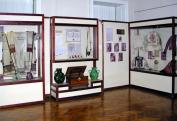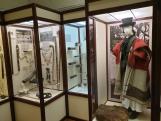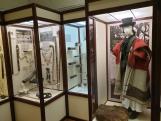2025. July 9. Wednesday
Rippl-Rónai Museum - Kaposvár
|
|
Address: 7400, Kaposvár Fő u. 10.
Phone number: (20) 287-9323
E-mail: titkarsag@smmi.hu
Opening hours: 01.04-31.10.: Tue-Sun 10-16
01.11-31.03.: Tue-Sun 10-15 |
Museum tickets, service costs:
|
Individual ticket for adults
|
800 HUF
|
|
|
Group ticket for adults
(over 10 people)
|
700 HUF
|
/ capita
|
|
Individual ticket for students
|
400 HUF
|
|
|
Group ticket for students
(over 10 people)
|
350 HUF
|
/ capita
|
|
Individual ticket for pensioners
|
400 HUF
|
|
|
Group ticket for pensioners
(over 10 people)
|
350 HUF
|
/ capita
|
|
Ticket for families
|
1700 HUF
|
/ family
|
|
Group program ticket for children
|
700 HUF
|
|
|
Season ticket
|
2300 HUF
|
|
|
Individual season ticket
|
1200 HUF
|
/ capita / 4 occasions
|
|
Group professional guide
|
2800 HUF
|
/ group / exhibition
|
Our exhibition presents the significant themes of the ornamentals of Somogy County. The material is taken form a collection assembled from the beginning of the 20th century.

The first ward is the location of wooden carved objects and equipment of shepherds and peasants. The traditions of the so-called 'betyár', the outlaws are also presented in this ward. In the second ward, the nicest pieces of guilds of the tailors, furriers, and dyers, who mainly worked for the peasants and shepherds can be seen. The cotton-cloths making was a very important feature of the area, especially in Szelic and in the villages in inner Somogy. Cotton-clothing was favored until the beginning of the 20th century. The third ward presents the differences in the ornamentals according to their regions of their making. We can see simple hemp textile as well as ornamented buns worn in the villages made by specialists.
Among the festive clothing, we can see that from Csurgónagymarton, Törökkoppány, Karád, Szenna, Lakócsa, and Szulok. In the fourth ward, the visitors may study the differences in the color of the mourning textiles and clothing. The reason we present these is the fact that the white mourning cloth was preserved in the tradition of the population of Zselic and Somogy until the beginning of the 20th century.

The first ward is the location of wooden carved objects and equipment of shepherds and peasants. The traditions of the so-called 'betyár', the outlaws are also presented in this ward. In the second ward, the nicest pieces of guilds of the tailors, furriers, and dyers, who mainly worked for the peasants and shepherds can be seen. The cotton-cloths making was a very important feature of the area, especially in Szelic and in the villages in inner Somogy. Cotton-clothing was favored until the beginning of the 20th century. The third ward presents the differences in the ornamentals according to their regions of their making. We can see simple hemp textile as well as ornamented buns worn in the villages made by specialists.
Among the festive clothing, we can see that from Csurgónagymarton, Törökkoppány, Karád, Szenna, Lakócsa, and Szulok. In the fourth ward, the visitors may study the differences in the color of the mourning textiles and clothing. The reason we present these is the fact that the white mourning cloth was preserved in the tradition of the population of Zselic and Somogy until the beginning of the 20th century.
|
Related activities
|
|


